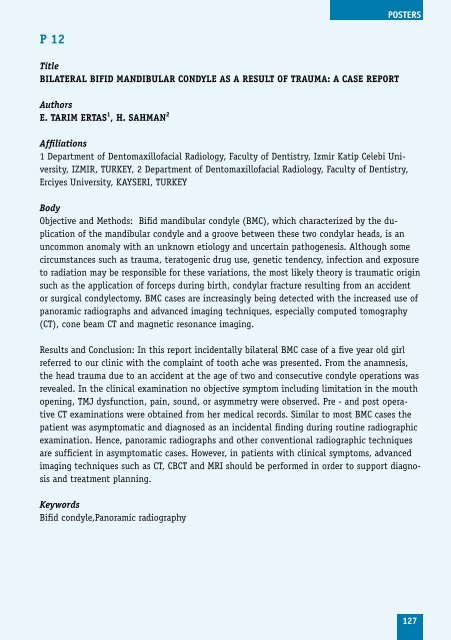Program including abstracts as pdf available here
Program including abstracts as pdf available here
Program including abstracts as pdf available here
Create successful ePaper yourself
Turn your PDF publications into a flip-book with our unique Google optimized e-Paper software.
P 12<br />
Title<br />
bILATERAL bIFID MANDIbuLAR CONDyLE AS A RESuLT OF TRAuMA: A CASE REPORT<br />
Authors<br />
E. TARIM ERTAS 1 , H. SAHMAN 2<br />
Affiliations<br />
1 Department of Dentomaxillofacial Radiology, Faculty of Dentistry, Izmir Katip Celebi University,<br />
IZMIR, TURKEY, 2 Department of Dentomaxillofacial Radiology, Faculty of Dentistry,<br />
Erciyes University, KAYSERI, TURKEY<br />
Body<br />
Objective and Methods: Bifid mandibular condyle (BMC), which characterized by the duplication<br />
of the mandibular condyle and a groove between these two condylar heads, is an<br />
uncommon anomaly with an unknown etiology and uncertain pathogenesis. Although some<br />
circumstances such <strong>as</strong> trauma, teratogenic drug use, genetic tendency, infection and exposure<br />
to radiation may be responsible for these variations, the most likely theory is traumatic origin<br />
such <strong>as</strong> the application of forceps during birth, condylar fracture resulting from an accident<br />
or surgical condylectomy. BMC c<strong>as</strong>es are incre<strong>as</strong>ingly being detected with the incre<strong>as</strong>ed use of<br />
panoramic radiographs and advanced imaging techniques, especially computed tomography<br />
(CT), cone beam CT and magnetic resonance imaging.<br />
Results and Conclusion: In this report incidentally bilateral BMC c<strong>as</strong>e of a five year old girl<br />
referred to our clinic with the complaint of tooth ache w<strong>as</strong> presented. From the anamnesis,<br />
the head trauma due to an accident at the age of two and consecutive condyle operations w<strong>as</strong><br />
revealed. In the clinical examination no objective symptom <strong>including</strong> limitation in the mouth<br />
opening, TMJ dysfunction, pain, sound, or <strong>as</strong>ymmetry were observed. Pre - and post operative<br />
CT examinations were obtained from her medical records. Similar to most BMC c<strong>as</strong>es the<br />
patient w<strong>as</strong> <strong>as</strong>ymptomatic and diagnosed <strong>as</strong> an incidental finding during routine radiographic<br />
examination. Hence, panoramic radiographs and other conventional radiographic techniques<br />
are sufficient in <strong>as</strong>ymptomatic c<strong>as</strong>es. However, in patients with clinical symptoms, advanced<br />
imaging techniques such <strong>as</strong> CT, CBCT and MRI should be performed in order to support diagnosis<br />
and treatment planning.<br />
Keywords<br />
Bifid condyle,Panoramic radiography<br />
POSTerS<br />
127


